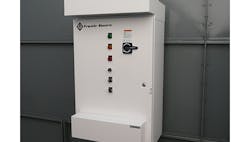Growing from an applications engineer to project sales engineer, Cody Lorenz is one of Franklin Electric's veteran controls experts. He has nearly 10 years of experience developing and implementing hardware and software improvements for Franklin's starters and drives.
What have been the biggest improvements to motors and drives in the past five years?
Cody Lorenz, project sales engineer, Franklin Electric: There has been a rise in the popularity of motor designs powered by permanent-magnet (PM) technology, which offer superior energy efficiency and improved handling of rapid system load changes. PM motors have been used regularly in many other industries—automotive and household appliances, to name a few—and are growing in popularity in our industry, and for good reason.
Also read: Ease of use dominates motor and drive trends
Permanent-magnet motors operate more efficiently using rare-earth magnets that perform with no slip. This translates into lower input power for the same output power, saving on operational costs every time the motor runs. In fact, we’ve found that motors with a 94% efficiency rating provide an investment payback of less than two years in typical duty-rate applications.
The most significant positive change for drives has been the acceptance to use them over starters, especially soft starters. With the acceptance of drives increasing, more installs are utilizing the unique control features they offer. This has inspired new opportunities for competition in the space to further innovate on the technology—the most prominent of recent developments being Internet and Bluetooth-enabled connectivity.
What's the most innovative or efficient motor/drive application you've ever seen or been involved with?
Cody Lorenz, project sales engineer, Franklin Electric: Franklin Electric's MagForce high-efficiency motors paired with an engineered drive solution, such as SubDrive Connect Plus or Cerus X-Drive, address projects up to 300 hp. A complete pumping solution can unleash groundbreaking efficiency when pairing a submersible pump with the unparalleled MagForce high-efficiency motor and a compatible variable-frequency drive for an intuitive experience. They are optimized to work together to achieve the highest performance and efficiency possible.
Franklin Electric has also leveraged its submersible-motor manufacturing experience to design an in-house purpose-built permanent-magnet submersible motor.
Permanent-magnet motors are inherently more efficient than their squirrel-cage counterparts. Since the motors were engineered to only be run by a drive, these motors are built with a higher pole count that can take advantage of the higher base frequencies that drives allow.
In addition, we programmed our drive to offer pre-configured settings specific to these motors. This resulted in the package system reaching a motor efficiency rating of 90 to 94%, reducing system energy consumption by 21%.
How have motors and drives benefitted from remote monitoring and connectivity?
Cody Lorenz, project sales engineer, Franklin Electric: The opportunity to have wireless connectivity is invaluable to drive users, but it’s equally important that this connectivity be intuitive to use. As a manufacturer, ease of use has always been critical as we develop and enhance our drive offering.
With any of our connected drives, customers can download all the drive settings and logs via Bluetooth and email them directly to our dedicated technical support team. This connectivity also allows us to help our customers streamline the commissioning process. It can save installers several hours on the jobsite, since they no longer need to manually record each drive’s programmed settings during installation and start-up.
Can you explain how software development has changed motor and drive design and production?
Cody Lorenz, project sales engineer, Franklin Electric: Apart from the connectivity side of the drive, most of the changes to drive design and production have paralleled other software-heavy markets.
Several decades ago, drives were using bulky hardware-based logic. Today, they use streamlined assembly language and embedded software designs that is more compact and easier for the average person to program and operate.
The advanced nature of the units also allows them to have more computing power while drawing less electrical current and occupying a smaller physical space: what’s known as power density. The microcontrollers have become more powerful, allowing more features to fit into the drive without increasing the cost. Drives have enough computing power to remain generalized products while utilizing integrated PLCs, multiple motor control methods and a wide breadth of I/O. Increasing power density also allows owners and operators to benefit from more streamlined units that are easier to ship and install without sacrificing performance or reliability.
When will motors and drives become IT-friendly enough that engineers are no longer required for installation and operation?
Cody Lorenz, project sales engineer, Franklin Electric: Drives have already started taking several steps to improve accessibility—a common one is an application parameter that auto-adjusts the rest of the parameters to suit it—and, more recently, the connectivity of drives. Adding connectivity allows a customer to quickly loop in another person with deep knowledge of the product. Future steps could be a connected product grabbing motor information from a product database to set up and configure the motor parameters itself, or even direct communications between the motor and drive to exchange this information.
What future innovations will impact the use of motors and drives in discrete-manufacturing operations?
Cody Lorenz, project sales engineer, Franklin Electric: Fundamentally, I do not think drives will change much. Yes, there will be reductions in size and increases in efficiency, but I do not believe there will be a significant innovation that changes drives for some time. More likely, we will see a few things:
- First, we will see a general decrease in cost per power, which may show up as an increase in power density. This will cause drives to expand into more applications as it becomes cost-effective to do so.
- Second, we will see more integrated packaging of drives and motors, likely for these new applications that have developed.
- Third, we will see an expansion of secondary features that boost ease of use and adoption, similar to the recent addition of wireless connectivity.
- And last, we will see more various power components packaged inside the drive instead of in a panel, driven by an increase in electric emission standards or the desire for a self-contained unit.
Mike Bacidore is the editor in chief for Control Design magazine. He is an award-winning columnist, earning a Gold Regional Award and a Silver National Award from the American Society of Business Publication Editors. Email him at [email protected].
About the Author
Mike Bacidore
Editor in Chief
Mike Bacidore is chief editor of Control Design and has been an integral part of the Endeavor Business Media editorial team since 2007. Previously, he was editorial director at Hughes Communications and a portfolio manager of the human resources and labor law areas at Wolters Kluwer. Bacidore holds a BA from the University of Illinois and an MBA from Lake Forest Graduate School of Management. He is an award-winning columnist, earning multiple regional and national awards from the American Society of Business Publication Editors. He may be reached at [email protected]

Leaders relevant to this article:



